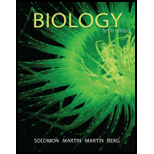
Biology (MindTap Course List)
10th Edition
ISBN: 9781285423586
Author: Eldra Solomon, Charles Martin, Diana W. Martin, Linda R. Berg
Publisher: Cengage Learning
expand_more
expand_more
format_list_bulleted
Concept explainers
Question
Chapter 15.1, Problem 2LO
Summary Introduction
To distinguish: A genomic DNA library and a complementary DNA (cDNA) library and to explain the reason why one would clone the same eukaryotic gene from both a genomic DNA library and a cDNA library.
Introduction: Deoxyribonucleic acid (DNA) libraries are constructed by scientists using genetic engineering techniques for gene cloning. There are mainly two types of libraries that can be used to isolate specific DNAs, such as genomic and complementary DNA (cDNA) libraries.
Expert Solution & Answer
Trending nowThis is a popular solution!

Students have asked these similar questions
The following table is from Kumar et. al. Highly Selective Dopamine D3 Receptor (DR) Antagonists and Partial Agonists Based on Eticlopride and the D3R Crystal Structure: New Leads for Opioid Dependence Treatment. J. Med Chem 2016.
The following figure is from Caterina et al. The capsaicin receptor: a heat activated ion channel in the
pain pathway. Nature, 1997. Black boxes indicate capsaicin, white circles indicate resinferatoxin.
You are a chef in a fancy new science-themed restaurant. You have a recipe that calls for 1 teaspoon of resinferatoxin, but you feel uncomfortable serving foods with "toxins" in them. How much capsaicin could you substitute instead?
What protein is necessary for packaging acetylcholine into synaptic vesicles?
Chapter 15 Solutions
Biology (MindTap Course List)
Ch. 15.1 - Prob. 1LOCh. 15.1 - Prob. 1CCh. 15.1 - Prob. 2LOCh. 15.1 - Prob. 3LOCh. 15.1 - Prob. 4LOCh. 15.1 - What do genomic DNA libraries and cDNA libraries...Ch. 15.1 - Prob. 3CCh. 15.2 - Prob. 5LOCh. 15.2 - Prob. 6LOCh. 15.2 - Prob. 7LO
Ch. 15.2 - Prob. 1CCh. 15.2 - Prob. 2CCh. 15.3 - Describe how genome-wide association studies have...Ch. 15.3 - Explain how targeted gene silencing and knockout...Ch. 15.3 - Prob. 1CCh. 15.4 - Describe at least one important application of DNA...Ch. 15.4 - Prob. 1CCh. 15.4 - What are short tandem repeats (STRs), and why are...Ch. 15.4 - Why do gene targeting and mutagenesis screening in...Ch. 15.5 - Describe at least two safety issue associated with...Ch. 15.5 - What are some of the environment concerns...Ch. 15 - A plasmid (a) can be used as a DNA vector (b) is a...Ch. 15 - DNA molecules with complementary sticky ends...Ch. 15 - Prob. 3TYUCh. 15 - Which technique rapidly replicated specific DNA...Ch. 15 - Prob. 5TYUCh. 15 - A cDNA clone contains (a) introns (b) exons (c)...Ch. 15 - Prob. 7TYUCh. 15 - Gel electrophoresis separates nucleic acids on the...Ch. 15 - Prob. 9TYUCh. 15 - DNA molecular with complementary sticky ends...Ch. 15 - These highly polymorphic molecular markers are...Ch. 15 - Prob. 12TYUCh. 15 - Prob. 13TYUCh. 15 - Prob. 14TYUCh. 15 - EVOLUTION LINK DNA technology, such as the...Ch. 15 - SCIENCE, TECHNOLOGY, AND SOCIETY What are some...
Knowledge Booster
Learn more about
Need a deep-dive on the concept behind this application? Look no further. Learn more about this topic, biology and related others by exploring similar questions and additional content below.Similar questions
- 1. Match each vocabulary term to its best descriptor A. affinity B. efficacy C. inert D. mimic E. how drugs move through body F. how drugs bind Kd Bmax Agonist Antagonist Pharmacokinetics Pharmacodynamicsarrow_forward50 mg dose of a drug is given orally to a patient. The bioavailability of the drug is 0.2. What is the volume of distribution of the drug if the plasma concentration is 1 mg/L? Be sure to provide units.arrow_forwardDetermine Kd and Bmax from the following Scatchard plot. Make sure to include units.arrow_forward
- Choose a catecholamine neurotransmitter and describe/draw the components of the synapse important for its signaling including synthesis, packaging into vesicles, receptors, transporters/degradative enzymes. Describe 2 drugs that can act on this system.arrow_forwardThe following figure is from Caterina et al. The capsaicin receptor: a heat activated ion channel in the pain pathway. Nature, 1997. Black boxes indicate capsaicin, white circles indicate resinferatoxin. a) Which has a higher potency? b) Which is has a higher efficacy? c) What is the approximate Kd of capsaicin in uM? (you can round to the nearest power of 10)arrow_forwardWhat is the rate-limiting-step for serotonin synthesis?arrow_forward
arrow_back_ios
SEE MORE QUESTIONS
arrow_forward_ios
Recommended textbooks for you
 Biology 2eBiologyISBN:9781947172517Author:Matthew Douglas, Jung Choi, Mary Ann ClarkPublisher:OpenStax
Biology 2eBiologyISBN:9781947172517Author:Matthew Douglas, Jung Choi, Mary Ann ClarkPublisher:OpenStax Concepts of BiologyBiologyISBN:9781938168116Author:Samantha Fowler, Rebecca Roush, James WisePublisher:OpenStax College
Concepts of BiologyBiologyISBN:9781938168116Author:Samantha Fowler, Rebecca Roush, James WisePublisher:OpenStax College Biology: The Dynamic Science (MindTap Course List)BiologyISBN:9781305389892Author:Peter J. Russell, Paul E. Hertz, Beverly McMillanPublisher:Cengage Learning
Biology: The Dynamic Science (MindTap Course List)BiologyISBN:9781305389892Author:Peter J. Russell, Paul E. Hertz, Beverly McMillanPublisher:Cengage Learning Biology (MindTap Course List)BiologyISBN:9781337392938Author:Eldra Solomon, Charles Martin, Diana W. Martin, Linda R. BergPublisher:Cengage Learning
Biology (MindTap Course List)BiologyISBN:9781337392938Author:Eldra Solomon, Charles Martin, Diana W. Martin, Linda R. BergPublisher:Cengage Learning Human Heredity: Principles and Issues (MindTap Co...BiologyISBN:9781305251052Author:Michael CummingsPublisher:Cengage LearningCase Studies In Health Information ManagementBiologyISBN:9781337676908Author:SCHNERINGPublisher:Cengage
Human Heredity: Principles and Issues (MindTap Co...BiologyISBN:9781305251052Author:Michael CummingsPublisher:Cengage LearningCase Studies In Health Information ManagementBiologyISBN:9781337676908Author:SCHNERINGPublisher:Cengage

Biology 2e
Biology
ISBN:9781947172517
Author:Matthew Douglas, Jung Choi, Mary Ann Clark
Publisher:OpenStax

Concepts of Biology
Biology
ISBN:9781938168116
Author:Samantha Fowler, Rebecca Roush, James Wise
Publisher:OpenStax College

Biology: The Dynamic Science (MindTap Course List)
Biology
ISBN:9781305389892
Author:Peter J. Russell, Paul E. Hertz, Beverly McMillan
Publisher:Cengage Learning

Biology (MindTap Course List)
Biology
ISBN:9781337392938
Author:Eldra Solomon, Charles Martin, Diana W. Martin, Linda R. Berg
Publisher:Cengage Learning

Human Heredity: Principles and Issues (MindTap Co...
Biology
ISBN:9781305251052
Author:Michael Cummings
Publisher:Cengage Learning

Case Studies In Health Information Management
Biology
ISBN:9781337676908
Author:SCHNERING
Publisher:Cengage
Genome Annotation, Sequence Conventions and Reading Frames; Author: Loren Launen;https://www.youtube.com/watch?v=MWvYgGyqVys;License: Standard Youtube License